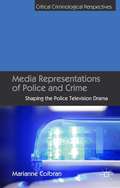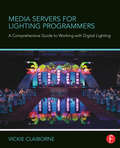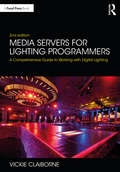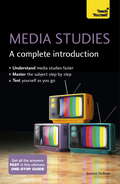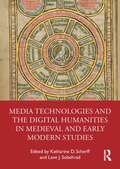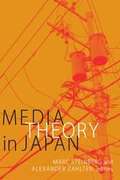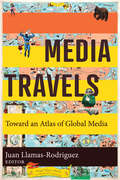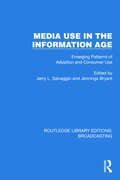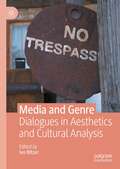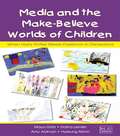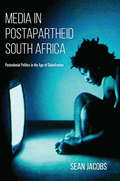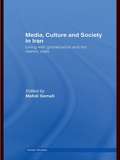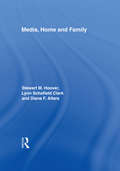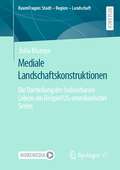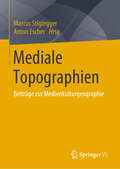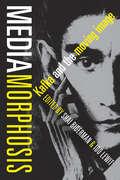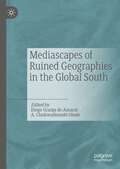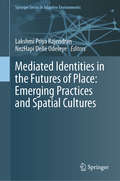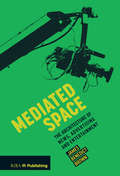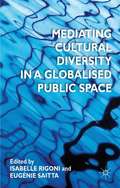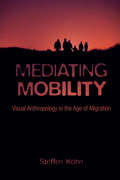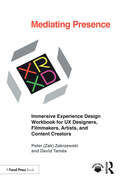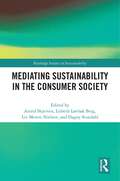- Table View
- List View
Media Representations of Police and Crime
by Marianne ColbranThis unique book explores the social processes which shape fictional representations of police and crime in television dramas. Exploring ten leading British and European police dramas from the last twenty-five years, Colbran, a former scriptwriter, presents a revealing insight into police dramas, informed by media and criminological theory.
Media Servers for Lighting Programmers: A Comprehensive Guide to Working with Digital Lighting
by Vickie ClaiborneMedia Servers for Lighting Programmers is the reference guide for lighting programmers working with media servers – the show control devices that control and manipulate video, audio, lighting, and projection content that have exploded onto the scene, becoming the industry standard for live event productions, TV, and theatre performances. This book contains all the information you need to know to work effectively with these devices, beginning with coverage of the most common video equipment a lighting programmer encounters when using a media server - including terminology and descriptions - and continuing on with more advanced topics that include patching a media server on a lighting console, setting up the lighting console for use with a media server, and accessing the features of the media server via a lighting console. The book also features a look at the newest types of digital lighting servers and products. This book contains: Never-before-published information grounded in author Vickie Claiborne’s extensive knowledge and experience Covers newest types of digital lighting servers and products including media servers, software, and LED products designed to be used with video Companion website with additional resources and links to additional articles on PLSN
Media Servers for Lighting Programmers: A Comprehensive Guide to Working with Digital Lighting
by Vickie ClaiborneMedia Servers for Lighting Programmers, Second Edition, is the reference guide for lighting programmers working with media servers – the digital media devices used to control and manipulate video, audio, lighting, and projection content that have become the industry standard for live events, broadcast, and theatre performances. This book contains all the information you need to begin working with these devices, with topics ranging from common video terminology and equipment to the workflows for setup, patching, programming, and operating a media server from a lighting console via DMX. It also features a brief history of where this unique market originated from and offers a look at the current trends in media server technology and the growing digital media industry. This second edition also includes more information on alternative methods of programming and operating a server beyond using DMX, along with new information on projection mapping workflows, content creation software, and media management techniques. Media Servers for Lighting Programmers, Second Edition, is a valuable resource for the lighting programmer working in live entertainment venues. The book includes access to additional online support material and links to industry sites and articles.
Media Studies: A Complete Introduction: Teach Yourself
by Joanne HollowsWritten by an academic and researcher with over twenty years' experience in teaching and convening Media Studies courses, Media Studies: A Complete Introduction is designed to give you everything you need to succeed, all in one place. It covers the key areas that students are expected to be confident in, outlining the basics in clear jargon-free English, and then providing added-value features like case studies, and even lists of questions you might be asked in your seminar or exam.The book uses a structure that mirrors the way Media Studies is taught on many university courses. Chapters include essential coverage of the history, organization and production of the media industries, and regulation of the media. The analysis of media texts is covered in detail, as are the issues of identity and gender, the idea of globalization and the shifting face of social media in its many contexts.
Media Technologies and the Digital Humanities in Medieval and Early Modern Studies
by Katharine D. Scherff Lane J. SobehradThrough a multidisciplinary collection of case studies, this book explores the effects of the digital age on medieval and early modern studies. Divided into five parts, the book examines how people, medieval and modern, engage with medieval media and technology through an exploration of the theory underpinning audience interactions with historical materials in the past and the real-world engagement of a twenty-first century audience with medieval and early modern studies through the multimodal lens of a vast digital landscape. Each case study reveals the diversity of medieval media and technology and challenges readers to consider new types of literacy competencies as scholarly, rigorous methods of engaging in pre-modern investigations of materiality. Essays in the first section engage in the examination of medieval media, mediation, and technology from a theoretical framework, while the second section explores how digitization, smart technologies, digital mapping, and the internet have shaped medieval and early modern studies today. The book will be of interest to students in undergraduate or graduate intermediate or advanced courses as well as scholars, in medieval studies, art history, architectural history, medieval history, literary history, and religious history.
Media Theory in Japan
by Alexander Zahlten Marc SteinbergProviding an overview of Japanese media theory from the 1910s to the present, this volume introduces English-language readers to Japan's rich body of theoretical and conceptual work on media for the first time. The essays address a wide range of topics, including the work of foundational Japanese thinkers; Japanese theories of mediation and the philosophy of media; the connections between early Japanese television and consumer culture; and architecture's intersection with communications theory. Tracing the theoretical frameworks and paradigms that stem from Japan's media ecology, the contributors decenter Eurocentric media theory and demonstrate the value of the Japanese context to reassessing the parameters and definition of media theory itself. Taken together, these interdisciplinary essays expand media theory to encompass philosophy, feminist critique, literary theory, marketing discourse, and art; provide a counterbalance to the persisting universalist impulse of media studies; and emphasize the need to consider media theory situationally. Contributors. Yuriko Furuhata, Aaron Gerow, Mark Hansen, Marilyn Ivy, Takeshi Kadobayashi, Keisuke Kitano, Akihiro Kitada, Thomas Looser, Anne McKnight, Ryoko Misono, Akira Mizuta Lippit, Fabian Schäfer, Marc Steinberg, Tomiko Yoda, Alexander Zahlten
Media Travels: Toward an Atlas of Global Media
by Juan Llamas-RodriguezMedia Travels: Toward An Atlas of Global Media fills a significant gap in global media scholarship by offering short, readable articles covering different types of media from around the world. Through careful and informed analysis, these eleven accessibly written chapters illustrate the particularities of different media practices and situate them within social, historical, and geographical contexts. Examples range from South African video games to Korean TV series popular in Latin America to Indigenous film and media from the US and Canada. Media studies courses, particularly introductory courses, are often narrowly focused on US and Western European canons. Instructors for introductory media studies courses wishing to expand the offerings in their curricula will find in these essays new ways of approaching foundational concepts and issues in the field, including globalization, social difference, and diverse media cultures. Scholars wishing to expand their research into specific media forms or representational issues can also turn to these case studies for approaches from beyond the US. By including a variety of media and several geographical areas, the collection introduces readers to the formal, technological, and cultural diversity of global media studies. Edited by Juan Llamas-Rodriguez with contributions from Anthony Adah and Añulika Agina, Maria Corrigan, Benjamin Han, Anna Shah Hoque, Meryem Kamil, Angelica Marie Lawson, Lilia Adriana Perez Limon, Sonia Robles, Kuhu Tanvir, David Tenorio, and Rachel van der Merwe.
Media Use in the Information Age: Emerging Patterns of Adoption and Consumer Use (Routledge Library Editions: Broadcasting #27)
by Jerry L. SalvaggioMedia Use in the Information Age (1989) analyses new technologies, their impact on mass communications, and their effects on the users of these new systems. It looks at technologies such as videotex, and their successes and failures around the world, and examines the early adoptions of technologies such as home computers.
Media and Genre: Dialogues in Aesthetics and Cultural Analysis
by Ivo RitzerThis book reflects and analyzes the relationship between media and genre, focusing on both aesthetics and discursive meaning. It considers genres as having a decisive impact on media cultures, either in film, on TV, in computer games, comics or radio, on the level of production as well as reception. The book discusses the role of genres in media and cultural theory as a configuration of media artifacts that share specific aesthetic characteristics. It also reflects genre as a concept of categorization of media artifacts with which the latter can be analyzed under terms depending on a specific historical situation or cultural context. A special focus is placed on trans-media perspectives. Even as genres develop their own traditions within one medium, they reach beyond a media-specific horizon, necessitating a double perspective that considers the distinct recourse to genre within a medium as well as the trans-media circulation and adaption of genres.
Media and the Affective Life of Slavery
by Allison PageHow media shapes our actions and feelings about race Amid fervent conversations about antiracism and police violence, Media and the Affective Life of Slavery delivers vital new ideas about how our feelings about race are governed and normalized by our media landscape. Allison Page examines U.S. media from the 1960s to today, analyzing how media culture instructs viewers to act and feel in accordance with new racial norms created for an era supposedly defined by an end to legal racism.From the classic television miniseries Roots to the edutainment video game Mission 2: Flight to Freedom and the popular website slaveryfootprint.org, Media and the Affective Life of Slavery provides an in-depth look at the capitalist and cultural artifacts that teach the U.S. public about slavery. Page theorizes media not only as a system of representation but also as a technology of citizenship and subjectivity, wherein race is seen as a problem to be solved. Ultimately, she argues that visual culture works through emotion, a powerful lever for shaping and managing racialized subjectivity. Media and the Affective Life of Slavery delivers compelling, provocative material and includes a wealth of archival research into such realms as news, entertainment, television, curricula, video games, and digital apps, providing new and innovative scholarship where none currently exists.
Media and the Make-Believe Worlds of Children: When Harry Potter Meets Pokemon in Disneyland (Routledge Communication Series)
by Dafna Lemish Maya Gotz Hyesung Moon Amy AidmanMedia and the Make-Believe Worlds of Children offers new insights into children's descriptions of their invented or "make-believe" worlds, and the role that the children's experience with media plays in creating these worlds. Based on the results of a cross-cultural study conducted in the United States, Germany, Israel, and South Korea, it offers an innovative look at media's role on children's creative lives.This distinctive volume:*outlines the central debates and research findings in the area of children, fantasy worlds, and the media;*provides a descriptive account of children's make-believe worlds and their wishes for actions they would like to take in these worlds;*highlights the centrality of media in children's make believe worlds;*emphasizes the multiple creative ways in which children use media as resources in their environment to express their own inner worlds; and*suggests the various ways in which the tension between traditional gender portrayals that continue to dominate media texts and children's wishes to act are presented in their fantasies.The work also demonstrates the value of research in unveiling the complicated ways in which media are woven into the fabric of children's everyday lives, examining the creative and sophisticated uses they make of their contents, and highlighting the responsibility that producers of media texts for children have in offering young viewers a wide array of role models and narratives to use in their fantasies. The downloadable resources provide full-color images of the artwork produced during the study.This book will appeal to scholars and graduate students in children and media, early childhood education, and developmental psychology. It can be used in graduate level courses in these areas.
Media in Postapartheid South Africa: Postcolonial Politics in the Age of Globalization
by Sean JacobsIn Media in Postapartheid South Africa, author Sean Jacobs turns to media politics and the consumption of media as a way to understand recent political developments in South Africa and their relations with the African continent and the world. Jacobs looks at how mass media define the physical and human geography of the society and what it means for comprehending changing notions of citizenship in postapartheid South Africa. Jacobs claims that the media have unprecedented control over the distribution of public goods, rights claims, and South Africa's integration into the global political economy in ways that were impossible under the state-controlled media that dominated the apartheid years. Jacobs takes a probing look at television commercials and the representation of South Africans, reality television shows and South African continental expansion, soap operas and postapartheid identity politics, and the internet as a space for reassertions and reconfigurations of identity. As South Africa becomes more integrated into the global economy, Jacobs argues that local media have more weight in shaping how consumers view these products in unexpected and consequential ways.
Media, Culture and Society in Iran: Living with Globalization and the Islamic State (Iranian Studies)
by Mehdi SematiBy exploring topics such as the Internet, print press, advertising, satellite television, video, rock music, literature, cinema, gender, religious intellectuals, and secularism, this unique and wide-ranging volume explains Iran as a complex society that has successfully managed to negotiate and embody the tensions of tradition and modernity, democracy and theocracy, isolation and globalization, and other such cultural-political dynamics that escape the explanatory and analytical powers of all-too-familiar binary relations. Featuring contributions from among the best-known and emerging scholars on Iranian media, culture, society, and politics, this volume uncovers how the existing perspectives on post-revolutionary Iranian society have failed to appreciate the complexity, the paradoxes and the contradictions that characterize life in contemporary Iran, resulting in a general failure to explain and to anticipate its contemporary social and political transformations.
Media, Home and Family
by Stewart M. Hoover Lynn Schofield Clark Diane F. AltersBased on extensive fieldwork, this book examines how parents make decisions regulating media use, and how media practices define contemporary family life.
Mediale Landschaftskonstruktionen: Die Darstellung des (sub)urbanen Lebens am Beispiel US-amerikanischer Serien (RaumFragen: Stadt – Region – Landschaft)
by Julia KlumpeIn diesem Buch erfolgen aus sozialkonstruktivistischer Perspektive eine qualitative Repräsentationsanalyse sowie eine quantitative Rezeptionsanalyse der drei US-amerikanischen Serien Gilmore Girls, Desperate Housewives und How I Met Your Mother. Die Autorin untersucht zum einen, welchen Einfluss die in den Serien gezeigten Landschaften auf die Wahrnehmung US-amerikanischer Landschaften durch die Rezipient*innen haben und stellt zum anderen heraus, inwieweit durch die dargestellten Landschaften Idealbilder konstruiert werden. Im Zentrum der Rezeptionsanalyse steht die Korpusanalyse entsprechender Fan-Foren. Untersucht wird, wie filmische Texte, insbesondere filmische Landschaften, in populäre Diskurse eingebettet werden.
Mediale Topographien: Beiträge zur Medienkulturgeographie
by Marcus Stiglegger Anton EscherFilmwissenschaftliche Analyse und die Methodik der Kulturgeographie werden in diesem neuartig perspektivierten Band zusammengeführt, um die medialen Topographien und Raumentwürfe des narrativen Films zu erkunden. Neben definitorischen Kapiteln zu Grundbegriffen der Filmgeographie finden sich Reflexionen zu den mythischen Räumen des Films, zur medialen Konstruktion ikonischer Orte (Casablanca, Tanger) sowie über die filmische Adaption von Grenz-Räumen und Konflikten (USA/Mexiko).
Mediamorphosis: Kafka and the Moving Image
by Shai Biderman Ido LewitThe idea of a visual manifestation of the work of Franz Kafka was denied by many—first and foremost by Kafka himself, who famously urged his publisher to avoid an image of an insect on the cover of Metamorphosis. Be that as it may, it is unlikely that such a central progenitor of twentieth-century art and thought as Kafka can be fully understood without reference to the revolutionary artistic medium of his century: cinema.Mediamorphosis compiles articles by some of today's leading forces in the scholarship of Kafka as well as film studies to provide a thorough investigation of the reciprocal relations between Kafka's work and the cinematic medium. The volume approaches the theoretical integration of Kafka and cinema via such issues as the cinematic qualities in Kafka's prose and the possibility of a visual manifestation of the Kafkaesque. Alongside these debates, the book investigates the capacity of cinema to incorporate and express the unique qualities of a Kafkaesque world through an analysis of cinematic adaptations of Kafka's prose, such as Michael Haneke's The Castle (1997) and Straub-Huillet's Class Relations (1984), as well as films that carry a more subtle relation to Kafka's oeuvre, such as the cinematic works of David Cronenberg, the films of the Coen brothers, Chris Marker's "film-essay," Charlie Chaplin's tramp, and others.
Mediascapes of Ruined Geographies in the Global South
by Diego Granja do Amaral A. Chukwudumebi ObuteThis book undertakes an interdisciplinary and cross-cultural interrogation of the Global South through the prisms of media and cultural studies. It closely explores the quotidian (re)territorialization, and brazen ruination of the material geographies of this vast expanse of the world by forces and proxies of (neo)colonialism and global capitalism of resource extraction. We cite the ongoing expulsion of Palestinians from their homelands by occupational forces, the emerging detritus dump across Mexico City and Lagos, the infrastructural precariousness of the favelas of Brazil, the unending resource-war in the Democratic Republic of Congo (DRC), and the flagrant operation of the oil industry in the Niger Delta region of Nigeria as examples of this geographic cataclysm. The centripetal forces of neo-colonialism and resource extraction at full-flight in the Global South, aided by toxic hegemonic forces, have overtly tossed some of the population to the peripheries of existence and the society at large. As such, this book, additionally, explores the resistance of the subalterns from the margins to this socio-political malaise, and further unmasks the knowledge production from these margins of the Global South. This project is divided into five (5) parts of three essays each. The first part examines the territorial contestation in the Middle East framed and expressed through films and literary lenses. The second part examines the environmental burden of modern consumerism and urbanization on metropolis across Mexico, Brazil, and Nigeria, while the third part explores the attritional violence of resource extraction in the DRC, Brazil, and Nigeria via filmic and journalistic lenses. The fourth part offers a swift response from the margins through ethnographic and journalistic interrogation of the subjectivity of the subalterns of Brazilian favelas, and street artists. The fifth part offers an engaging critique of the political climates of South Africa and Brazil that reinforce the environmental catastrophe of the regions of the world.
Mediated Identities in the Futures of Place: Emerging Practices and Spatial Cultures (Springer Series in Adaptive Environments)
by Lakshmi Priya Rajendran NezHapi Dellé OdeleyeThis book examines the emerging problems and opportunities that are posed by media innovations, spatial typologies, and cultural trends in (re)shaping identities within the fast-changing milieus of the early 21st Century.Addressing a range of social and spatial scales and using a phenomenological frame of reference, the book draws on the works of Heidegger, Merleau-Ponty and Don Hide to bridge the seemingly disparate, yet related theoretical perspectives across a number of disciplines. Various perspectives are put forward from media, human geography, cultural studies, technologies, urban design and architecture etc. and looked at thematically from networked culture and digital interface (and other) perspectives.The book probes the ways in which new digital media trends affect how and what we communicate, and how they drive and reshape our everyday practices. This mediatization of space, with fast evolving communication platforms and applications of digital representations, offers challenges to our notions of space, identity and culture and the book explores the diverse yet connected levels of technology and people interaction.
Mediated Space
by James BrownAs the social media revolution embeds itself in our daily lives, and as those who once consumed media become producers, established broadcast media producers are witnessing the dissolution of trust in their established authority. Mediated Space critiques contemporary intersections of Architecture and broadcast media that exploit spaces and places that are real, imagined or hybrids of the two in order to re-establish and strengthen the power of traditional capitalist mechanisms of production and consumption. Examining eight spatial constructions in North America, Europe, the Middle East and Africa, Mediated Space embarks on a global exploration of how architecture, spatial design and technology conspire in the service of global capitalism. In three thematic parts that focus on the automotive space of the city, the journalistic space of the news room and the mediated skyline of the city, Mediated Space makes an architectural critique of spaces that are rarely designed by architects but that are experienced every day by millions of people.
Mediating Alzheimer's: Cognition and Personhood
by Scott SelbergAn exploration of the representational culture of Alzheimer&’s disease and how media technologies shape our ideas of cognition and aging With no known cause or cure despite a century of research, Alzheimer&’s disease is a true medical mystery. In Mediating Alzheimer&’s, Scott Selberg examines the nature of this enduring national health crisis by looking at the disease&’s relationship to media and representation. He shows how collective investments in different kinds of media have historically shaped how we understand, treat, and live with this disease. Selberg demonstrates how the cognitive abilities that Alzheimer&’s threatens—memory, for example—are integrated into the operations of representational technologies, from Polaroid photographs to Post-its to digital artificial intelligence. Focusing on a wide variety of media technologies, such as neuroimaging, art therapy, virtual reality, and social media, he shows how these cognitively oriented media ultimately help define personhood for people with Alzheimer&’s. Media have changed the practices of successful aging in the United States, and Selberg takes us deep into how technologies like digital brain-training and online care networks shape ideas of cognition and healthy aging.Packed with startlingly fresh insights, Mediating Alzheimer&’s contributes to debates around bioethics, the labor of caregiving, and a national economy increasingly invested in communication and digital media. Probing the very technologies that promise to save and understand our brains, it gives us new ways of understanding Alzheimer&’s disease and aging in America.
Mediating Cultural Diversity in a Globalized Public Space
by Isabelle Rigoni Eugénie SaittaThrough enhancing reflection on the treatment of cultural diversity in contemporary Western societies, this collection aims to move the debate beyond the opposition between ethnicity and citizenship and demonstrate ways to achieve equality in multicultural and globalised societies.
Mediating Mobility: Visual Anthropology in the Age of Migration (Nonfictions)
by Steffen KöhnImages have become an integral part of the political regulation of migration: they help produce categories of legality versus illegality, foster stereotypes, and mobilize political convictions. Yet how are we to understand the relationship between these images and the political in the discourse surrounding migration? How can we, as anthropologists, migration scholars, or documentary filmmakers visually represent people who are excluded from political representation? And how can such visual representations gain political momentum? This volume not only considers the images that circulate with reference to migrants or draw attention to those that accompany, show, or conceal them. The book explores the phenomena of migration with the help of images. It offers an in-depth analysis of the documentary approaches of Ursula Biemann, Renzo Martens, Bouchra Khalili, Silvain George, Raphael Cuomo and Maria Iorio, Alex Rivera, and Rania Stepha, which evoke the particularities of migrant lifeworlds and examine urgent questions regarding the interrelations between politics and poetics, mobility and mediation, and the ethics of probability and possibility. The author also discusses his own cinematic practice in the making of Tell Me When... (2011), A Tale of Two Islands (2012), and Intimate Distance (2015), a trilogy of films that explore the potential to communicate the bodily, spatial, and temporal dimensions of the experience of migration.
Mediating Presence: Immersive Experience Design Workbook for UX Designers, Filmmakers, Artists, and Content Creators
by Peter Zakrzewski David TamésMediating Presence: Immersive Experience Design Workbook for UX Designers, Filmmakers, Artists, and Content Creators provides the foundation for a broader understanding of the impact of XR as the next medium. The methods presented draw from a wide range of disciplines and professional practice to provide a practical guide to design methods, production techniques, best practices, and terminology that provides an effective road map for developing immersive experiences using augmented reality, virtual reality, augmented virtuality, and other emerging immersive media forms.In this book, media designers Peter (Zak) Zakrzewski and David Tamés present a comprehensive framework for XR media experience design (XRXD) that will allow UX designers, filmmakers, artists, and content creators to connect their audiences to rich, multimodal, immersive experiences for entertainment, learning, creating, and healing. This book guides the reader through a 12+1-step design-based model for creating XR experiences. Each step is accompanied by specific media design methods expressly created for or adapted to XR content creation. The theoretical concepts and methods covered address the specific context and meaning aspects of the XR media environments being created.
Mediating Sustainability in the Consumer Society (Routledge Studies in Sustainability)
by Dagny Stuedahl Astrid Skjerven Lisbeth Løvbak Berg Liv Merete NielsenThis book sheds light on the role and impact of sustainability mediation, an effective tool for political authorities and business enterprises to persuade consumers of the integrity of their actions, products, and services.In this era of ecological and societal crises fuelled by increasing consumption, sustainability has become a key buzzword and target to attain. Governments around the world argue that they will meet their sustainability goals through environmental actions, by enabling consumers to make better choices and expecting brands to respond accordingly. At the same time, consumers are overwhelmed by the messaging conveyed in sustainability marketing campaigns, often featuring misleading greenwashing, with political authorities, organisations, and business enterprises all having conflicting interests. In this complex scenario, mediation has become a crucial issue. This book offers a critical and multidisciplinary view of sustainability mediation from experts in the fields of philosophy, consumption research, media studies, fashion, design, and citizenship, offering a unique, holistic view. Each chapter highlights different and problematic aspects of the cultural narratives being communicated, for example, the necessity of growth and the notion of a green economy. They present current theories, methods, indicators, and strategies used to assess and measure the relation between mediation, behaviour, and sustainable development.This book is of interest to scholars, researchers, and postgraduate students in all subject fields concerned with sustainability, including design, visual communication, fashion, consumption, media and journalism, and sustainable development.
